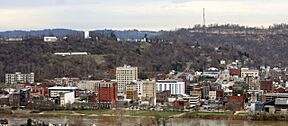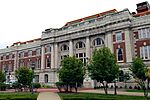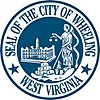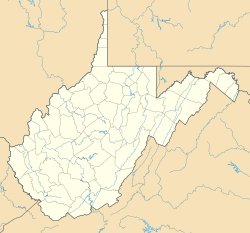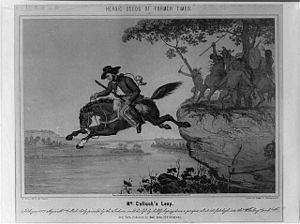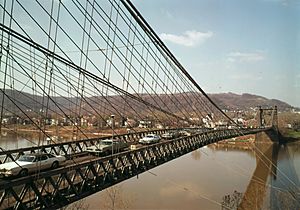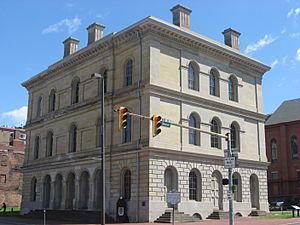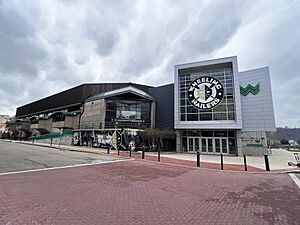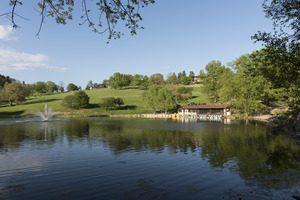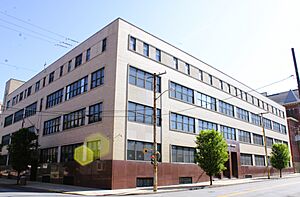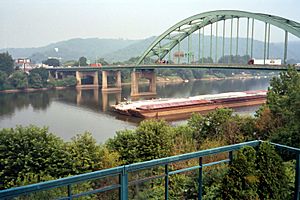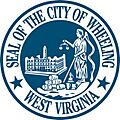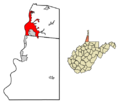Wheeling, West Virginia facts for kids
Quick facts for kids
Wheeling, West Virginia
|
|||
|---|---|---|---|
|
|
|||
|
|||
| Nickname(s):
The Friendly City
|
|||
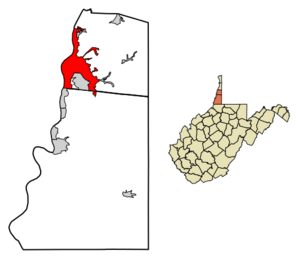
Location of Wheeling in Ohio and Marshall counties, West Virginia.
|
|||
| Country | |||
| State | |||
| County | Ohio, |
||
| Settled | 1769 | ||
| Established | 1806 | ||
| Incorporated | 1836 | ||
| Area | |||
| • City | 16.00 sq mi (41.43 km2) | ||
| • Land | 13.78 sq mi (35.68 km2) | ||
| • Water | 2.22 sq mi (5.76 km2) 13.87% | ||
| Elevation | 687–1,300 ft (209–396 m) | ||
| Population
(2020)
|
|||
| • City | 27,062 | ||
| • Density | 1,691.4/sq mi (653.20/km2) | ||
| • Urban | 81,249 (US: 353rd) | ||
| • Metro | 145,205 (US: 288th) | ||
| Time zone | UTC−5 (EST) | ||
| • Summer (DST) | UTC−4 (EDT) | ||
| ZIP Code |
26003
|
||
| Area code(s) | 304 | ||
| FIPS code | 54-86452 | ||
| GNIS feature ID | 1548994 | ||
| Website | www.wheelingwv.gov | ||
Wheeling is a city in Ohio and Marshall counties in the state of West Virginia. It is the county seat of Ohio County. The city is located along the Ohio River in the Appalachian Mountains. It is part of the state's Northern Panhandle.
In 2020, Wheeling had a population of 27,062 people. This makes it the fifth-largest city in West Virginia. It is also the largest city in the Northern Panhandle. The larger Wheeling metropolitan area had about 139,513 people in 2020. Wheeling is about 60 miles west of Pittsburgh and 120 miles east of Columbus. You can reach it by Interstate 70.
Wheeling was first settled in 1769. At that time, both Pennsylvania and Virginia claimed the land. It grew to be Virginia's largest city west of the Appalachian Mountains. During the American Civil War, Wheeling was very important. It hosted meetings that led to West Virginia separating from Virginia. It was the state capital from 1861 to 1870, and again from 1875 to 1885.
In the late 1800s, Wheeling became a major manufacturing hub. This was because of its location on important travel routes. These included the Ohio River, the National Road, and the Baltimore and Ohio Railroad. After World War II, heavy industry declined, and many people moved away. Today, Wheeling's main industries are healthcare, education, law, entertainment, tourism, and energy.
Contents
- Wheeling's Rich History: A Journey Through Time
- Where is Wheeling? Geography and Climate
- Who Lives in Wheeling? Demographics
- Arts, Culture, and Entertainment in Wheeling
- Sports in Wheeling
- Parks, Recreation, and Gaming
- Education in Wheeling
- Media: News, Radio, and TV
- Getting Around Wheeling: Roads and Transportation
- Famous People From Wheeling
- Images for kids
- See also
Wheeling's Rich History: A Journey Through Time
Early European Settlers and Claims
Native Americans lived in this area for thousands of years. In the 1600s, the Iroquois tribe from New York took over the upper Ohio Valley. They used it as their hunting grounds.
French explorers were the first Europeans to visit. In 1749, Céloron de Blainville buried a lead plate at Wheeling Creek. This was to mark France's claim to the land. Later, Christopher Gist and George Washington surveyed the area in 1751 and 1770.
How Wheeling Became a Town
In 1769, Ebenezer Zane explored the Wheeling area. He claimed land using "tomahawk rights." This meant marking trees with his initials. The next spring, he returned with his family. They started the first permanent European settlement, calling it Zanesburg. Other families, like the Shepherds and Wetzels, soon joined them.
In 1787, the United States gave this land to Virginia. Settlers then began moving into new areas along the Ohio River. In 1793, Ebenezer Zane divided the town into lots. Wheeling officially became a town in 1795. It was incorporated as a town in 1805 and then as the city of Wheeling on March 11, 1836. In 1797, Wheeling was named the county seat of Ohio County.
Fort Henry: A Story of Courage
The fort in Wheeling was first called Fort Fincastle in 1774. It was later renamed Fort Henry to honor Virginia's governor, Patrick Henry. In 1777, Native American tribes like the Shawnee, Wyandot, and Mingo attacked pioneer settlements. They hoped to drive settlers out of their land.
Local men defended the fort. They were joined by others from nearby forts. The attacking forces burned cabins and destroyed animals.
During one attack, Major Samuel McColloch led men to help Fort Henry. He was separated from his group and chased by Native Americans. McColloch rode his horse up Wheeling Hill and made a famous jump. This jump, known as McColloch's Leap, was 300 feet down the eastern side of the hill.
In 1782, Native American and British soldiers tried to capture Fort Henry. The fort ran out of ammunition. Betty Zane bravely volunteered to get more gunpowder from the Zane homestead. She ran there, filled a tablecloth with gunpowder, and ran back. She was shot at but was not hurt. Thanks to her bravery, Fort Henry stayed under American control.
Wheeling's Role as a Transportation Hub
The National Road reached Wheeling in 1818. This road connected the Ohio River to the Potomac River. It helped goods move from the Ohio Valley to the East. Wheeling became a key spot for people moving west. In 1849, the Wheeling Suspension Bridge was built across the Ohio River. This allowed the city to grow onto Wheeling Island. The lessons learned from building this bridge helped in building the Brooklyn Bridge.
Rail transportation came to Wheeling in 1853. The Baltimore and Ohio Railroad connected Wheeling to Pennsylvania, Maryland, and eastern markets. A bridge over the river also connected it to Bellaire, Ohio and areas further west.
Wheeling and the Civil War
Many people in this area were farmers who did not own slaves. As industry grew, more people depended on free labor. The Wheeling Intelligencer newspaper showed the area's strong feelings against leaving the Union.
Wheeling became part of the movement for western Virginia to separate from Virginia. This happened after the Civil War began. The city hosted the Wheeling Conventions. These meetings led to West Virginia becoming a new state. Wheeling was the temporary capital of the Restored Government of Virginia from 1861 to 1863. It became the first capital of West Virginia in 1863.
German immigrants, many of whom came after the 1848 Revolutions, were strongly against slavery. Germans in Wheeling formed the "First West Virginia Artillery" to fight against the Confederacy. Their culture also influenced the city, with "German Singing Societies" starting in 1855.
Growth After the Civil War
Wheeling continued to grow even after losing its capital status in 1865. In the late 1800s, it was a major industrial center. Famous businesses included the Bloch Brothers Tobacco Company and steel companies. As the city grew, wealthy residents built beautiful homes around Wheeling Island.
Wheeling's population reached its highest point in 1930. The Great Depression and changes in heavy industry after World War II caused many jobs to be lost. This led to a decrease in population. Today, Wheeling is working to bring back its downtown area and promote tourism. It is also becoming a center for health services and education.
Where is Wheeling? Geography and Climate
Wheeling is located at 40°4′13″N 80°41′55″W / 40.07028°N 80.69861°W. The city covers about 16.01 square miles (41.43 square kilometers). About 13.79 square miles (35.68 square kilometers) is land, and 2.22 square miles (5.76 square kilometers) is water.
Wheeling is in the northern part of West Virginia, in what is called the northern panhandle. It is part of the Western Allegheny Plateau. The city is right across the Ohio River from Ohio. It is also only 11 miles (18 km) west of Pennsylvania. This area is often called the Ohio River Valley Region.
Wheeling Creek flows through the city. It meets the Ohio River in downtown Wheeling. The city is on both the West Virginia side of the Ohio River and on Wheeling Island, an island in the middle of the river.
Wheeling's Weather: Hot Summers, Cold Winters
Wheeling has a climate that is a mix of humid subtropical and humid continental. This means it has hot, humid summers and cold winters. The city gets about 37 inches (940 mm) of rain each year.
| Climate data for Wheeling, West Virginia | |||||||||||||
|---|---|---|---|---|---|---|---|---|---|---|---|---|---|
| Month | Jan | Feb | Mar | Apr | May | Jun | Jul | Aug | Sep | Oct | Nov | Dec | Year |
| Mean daily maximum °C (°F) | 2.7 (36.9) |
4.8 (40.6) |
11 (52) |
17.1 (62.8) |
22.7 (72.9) |
27.1 (80.8) |
29 (84) |
28.3 (82.9) |
25.1 (77.2) |
18.7 (65.7) |
11.8 (53.2) |
5.3 (41.5) |
17.0 (62.5) |
| Daily mean °C (°F) | −2.4 (27.7) |
−0.9 (30.4) |
4.7 (40.5) |
10.2 (50.4) |
15.6 (60.1) |
20.3 (68.5) |
22.6 (72.7) |
22 (72) |
18.5 (65.3) |
11.8 (53.2) |
6.1 (43.0) |
0.5 (32.9) |
10.8 (51.4) |
| Mean daily minimum °C (°F) | −7.5 (18.5) |
−6.6 (20.1) |
−1.5 (29.3) |
3.3 (37.9) |
8.6 (47.5) |
13.6 (56.5) |
16.3 (61.3) |
15.7 (60.3) |
11.9 (53.4) |
5 (41) |
0.5 (32.9) |
−4.2 (24.4) |
5 (41) |
| Average rainfall mm (inches) | 63 (2.5) |
61 (2.4) |
87 (3.4) |
90 (3.5) |
103 (4.1) |
98 (3.9) |
108 (4.3) |
93 (3.7) |
78 (3.1) |
66 (2.6) |
80 (3.1) |
72 (2.8) |
999 (39.4) |
| Source: http://en.climate-data.org/location/1626/ | |||||||||||||
Who Lives in Wheeling? Demographics
| Historical population | |||
|---|---|---|---|
| Census | Pop. | %± | |
| 1840 | 7,885 | — | |
| 1850 | 11,435 | 45.0% | |
| 1860 | 14,083 | 23.2% | |
| 1870 | 19,280 | 36.9% | |
| 1880 | 30,737 | 59.4% | |
| 1890 | 34,522 | 12.3% | |
| 1900 | 38,878 | 12.6% | |
| 1910 | 41,641 | 7.1% | |
| 1920 | 56,208 | 35.0% | |
| 1930 | 61,659 | 9.7% | |
| 1940 | 61,099 | −0.9% | |
| 1950 | 58,891 | −3.6% | |
| 1960 | 53,400 | −9.3% | |
| 1970 | 48,188 | −9.8% | |
| 1980 | 43,070 | −10.6% | |
| 1990 | 34,882 | −19.0% | |
| 2000 | 31,419 | −9.9% | |
| 2010 | 28,486 | −9.3% | |
| 2020 | 27,062 | −5.0% | |
| U.S. Decennial Census | |||
Wheeling's Population in 2020
In 2020, there were 27,052 people living in Wheeling. There were 11,737 households. The city had 14,407 housing units. Most residents (86.5%) were White. About 5.5% were African American, and 1.1% were Asian. People of two or more races made up 6% of the population. Hispanic or Latino people were 1.7% of the population.
The average household size was 3.16 people. The median age in the city was 43.6 years. About 20.2% of the population was under 18 years old. The average income for a household was $43,483. The poverty rate was 16.5%.
Arts, Culture, and Entertainment in Wheeling
Wheeling has a rich history and culture. West Virginia Independence Hall is a very important building. It was where meetings were held in 1861. These meetings led to West Virginia becoming a separate state from Virginia. The oldest building in the area is Shepherd Hall (Monument Place), built in 1798.

Wheeling is home to Centre Market. This used to be the city's market house. Built in 1853, it now has shops and restaurants.
Wheeling also has a special memorial. It is the first official monument in West Virginia for soldiers killed in the Vietnam War. It was dedicated in 1986. The monument lists the names of those from the Wheeling area who died.
Theater and Music Venues
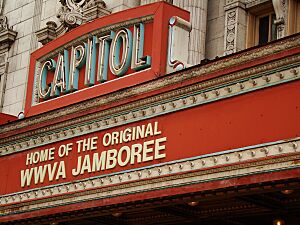
Wheeling offers several options for theater fans. The Capitol Theatre hosts many touring musical shows. The Oglebay Institute's Towngate Theatre has been putting on plays for over 35 years.
Wheeling has a long history of live music and radio. The Capitol Theatre, opened in 1928, is the largest theater in West Virginia. It used to be home to "It's Wheeling Steel," a popular radio show. Many famous musicians have performed there, from Johnny Cash to Bob Dylan.
The Wheeling Symphony Orchestra performs at the Capitol Theatre. They play a variety of music, including classical and modern songs.
The Victoria Theater is the oldest theater in West Virginia. It was home to the WWVA Jamboree radio show from 1933 to 1936. This show was the second-longest-running country radio program in the country.
Live music can be heard at the Wheeling Heritage Port. This waterfront park hosts concerts, festivals, and movie nights. It can hold over 8,000 people.
Jamboree in the Hills is a large country music festival. It used to be held near Wheeling and attracted over 100,000 fans every July.
Sports in Wheeling
Wheeling is known as Nail City. It is home to the Wheeling Nailers hockey team. The Nailers play at the WesBanco Arena. They are part of the ECHL league. High school football and soccer games are played at Wheeling Island Stadium.
Wheeling also hosts the Mountain East Conference basketball championship tournament. This is for college teams in NCAA Division II.
Parks, Recreation, and Gaming
Wheeling has several city parks. These include Oglebay Resort & Conference Center and Wheeling Park. Ohio County has six golf courses. Some were designed by famous golfers like Arnold Palmer.
In 2007, Wheeling opened the state's first concrete skateboard park. It is 12,000 square feet (1,115 square meters). The park has bowls and street elements. It is lit and open all the time.
Live Racing and Casino Games
Wheeling is home to Wheeling Island Hotel-Casino-Racetrack. This place used to be called Wheeling Downs. It has live greyhound racing, slots, poker games, and other casino-style table games.
In 2007, Ohio County voted to allow table games in the county.
Education in Wheeling
Schools for Kids and Teens
Public schools in West Virginia are managed by the county. Ohio County Schools has 14 schools. There are nine elementary schools and four middle schools. Wheeling Park High School is a nationally recognized high school.
Wheeling also has several private schools. These include Wheeling Central Catholic High School, the Linsly School, and Wheeling Country Day School.
Colleges and Universities
Wheeling is a center for higher education in the Northern Panhandle. Wheeling University is a private university. It is the only Catholic college in West Virginia.
West Virginia Northern Community College has its main campus in downtown Wheeling. It focuses on job training. Nearby, West Liberty University and Bethany College offer more options for higher education.
Media: News, Radio, and TV
Wheeling is close to Pittsburgh, so its residents get many TV and radio channels from there. Cable TV providers in Wheeling also carry Pittsburgh sports and news channels.
Wheeling has its own TV stations. These include WTRF-TV (ABC/CBS), W30CO-D (PBS), and WTOV-TV (NBC/FOX). Comcast is the main cable provider.
Wheeling is home to WWVA 1170 AM. This is West Virginia's only 50,000-watt AM radio station. It can be heard across the East Coast at night. Other local radio stations offer news, sports, talk, and music. WPHP 91.9 is a student-run radio station at Wheeling Park High School.
The city has two newspapers: The Intelligencer and the Wheeling News-Register. The Intelligencer is published weekday mornings and Saturdays. The News-Register is published weekday afternoons and Sundays. In Wheeling magazine covers local society and events. There are also local websites like Weelunk and Dateline: Wheeling for news.
Getting Around Wheeling: Roads and Transportation
Major Roads and Bridges
Interstate 70 and its branch Interstate 470 run through Wheeling. They connect the city to Pittsburgh in the east and Ohio in the west. U.S. Route 40 (the National Road) links downtown with eastern neighborhoods. West Virginia Route 2 connects Wheeling to Moundsville to the south and Weirton to the north. U.S. Route 250 also passes through the city.
The Fort Henry Bridge and Vietnam Veterans Memorial Bridge carry I-70 and I-470 over the Ohio River. The historic Wheeling Suspension Bridge, built in 1849, connects downtown and Wheeling Island. It is currently closed to cars for safety. I-70 goes under Wheeling Hill through the Wheeling Tunnel.
Bus and Air Travel
You can travel by bus from Wheeling to places across North America. Greyhound Lines serves the city from the Robert C. Byrd Intermodal Transportation Center. This center also serves local bus routes by the Ohio Valley Regional Transit Authority (OVRTA).
Wheeling used to have streetcars from the 1880s until 1943. Buses replaced them because they were cheaper to run.
The city has the Wheeling Ohio County Airport for smaller planes. For passenger flights, people use Pittsburgh International Airport.
Famous People From Wheeling
- Jodi Applegate, TV news anchor
- Leon "Chu" Berry, jazz saxophonist
- Jesse Burkett, Hall of Fame baseball player
- Jack Canfield, motivational speaker
- John Corbett, actor
- Rebecca Harding Davis, author
- Joyce DeWitt, actress
- Joanne Dru, actress
- Mike Florio, sportswriter
- Virginia Fox, actress
- Cynthia Germanotta, philanthropist and businesswoman, mother of Lady Gaga
- Chuck Howley, NFL linebacker
- Bill Mazeroski, Hall of Fame baseball player
- Walter Reuther, labor leader
- Eleanor Steber, opera singer
- Nan Wynn, big band singer and actress
Images for kids
See also
 In Spanish: Wheeling (Virginia Occidental) para niños
In Spanish: Wheeling (Virginia Occidental) para niños


